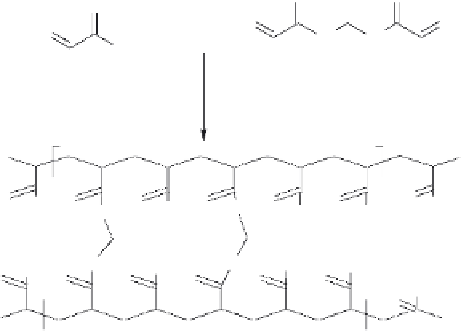Biomedical Engineering Reference
In-Depth Information
Methylenebisacrylamide
Acrylamide
O
O
O
CH
2
H
2
C
H
2
C
NH
NH
NH
2
S
2
O
8
2-
(persulphate ion)
H
3
C
CH
3
n
O
O
O
O
O
O
O
NH
NH
2
NH
2
HN
NH
2
NH
2
NH
2
NH
2
NH
2
NH
2
NH
NH
2
HN
O
O
O
O
O
O
NH
2
O
CH
3
H
3
C
m
Polyacrylamide (PAm) gel
PAm gel synthesis.
Figure 4.2
as the free radical polymerization initiator components; see
Figure 4.2
. Despite the
somewhat cluttered chemistry, a
fine transparent gel can be formed. By applying an
electric
field across the gel, typically swollen with buffer, proteins and nucleic acids can
be separated and visualized by appropriate staining.
Poly(acrylamide)
polymers are hydrophilic, but by making the
monomer core more hydrophobic, by N-isopropyl substituting the acrylamide monomer
to give N-isopropylacrylamide (NIPAm), new materials can be formed with intriguing
properties. Pure poly(NIPAm) gel materials are suf
-
polyAm or PAm
-
ciently hydrophobic that they tend
to phase-separate on heating, and tuned temperature-sensitive swelling/de-swelling can
be achieved by copolymerizing acrylamide, N-isopropyl acrylamide and bisacrylamide
in various proportions. One obvious aim of such work is to control the swelling or
de-swelling so it occurs around either room or body temperature, in so-called thermo-
responsive gels.
4.1.4
Copolymer networks
Some copolymer networks have already been mentioned, but great control and
flexi-
bility of
final properties can be gained by copolymerizing, say, urethane and urea with a
poly(ethylene oxide) and poly(propylene oxide) prepolymer referred to as PEO
-
PPO
to produce segmented copolymers (Stanford,
1998
). The urethane
-
urea segments tend
to be
ne-
tuned. Added to this, as is now well known, such segmented copolymers can undergo
phase separation; these systems often have complex morphologies, as discussed in
Chapter 6
.
'
hard
'
and the POE
-
PPO segments
'
soft
'
, so material properties can be

Search WWH ::

Custom Search